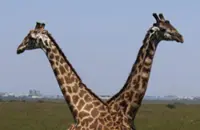The foxes attracted attention after a photographer shared pictures of the kits on Reddit. Photos: TNS
Below the towering skyscrapers lining Chicago’s Millennium Park, in the United States, an unlikely group is holing up in a garden: A family of foxes.
Several kits frolicked in Lurie Garden as their mother looked on a recent Sunday night. They played on the walkway, groomed one another atop a concrete slab and walked under metal gates lining the park.





